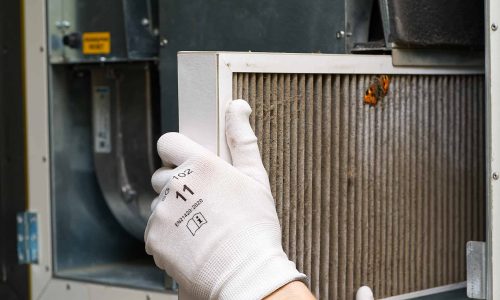A well-maintained furnace is essential for a comfortable and efficient home heating system. Among the critical components of a furnace is the flame sensor, which plays a vital role in detecting the presence of a flame and ensuring safe and efficient operation. However, there can also be a time when you need to know how to clean furnace flame sensors.
Over time, the flame sensor can become dirty or covered in residue, leading to malfunctions and potential system shutdowns. In this guide, we’ve gone deeper into the DIY approach to cleaning your furnace flame sensor, enabling you to maintain optimal performance and avoid unnecessary repair costs. If you need professional help at any point, just call our team at River Valley Air Conditioning, Inc.
Understanding the Flame Sensor
Before diving into the cleaning process, it’s essential to understand the purpose and functionality of the flame sensor. So, how does the flame sensor work its magic? Well, it’s a straightforward process. The sensor is usually made of a thin, metallic rod, often composed of stainless steel. It’s strategically positioned near the burners, in the path of the flame. When the furnace ignites, the burners produce a flame that engulfs the sensor.
The flame sensor is equipped with a small electrical current running through it. When the flame engulfs the sensor, it conducts the electrical current, signaling to the furnace’s control board that everything is okay. This signal lets the control board know that it’s safe to keep the gas valve open, allowing the burners to continue providing that warmth you crave.
The flame sensor isn’t just responsible for detecting the presence of a flame; it also acts as a safety feature. In the event that the sensor fails to detect a flame, it sends a signal to the control board to shut off the gas supply, preventing a potentially hazardous situation. This ensures that unburned gas doesn’t accumulate, protecting you and your home from potential dangers.
Signs of a Dirty Flame Sensor
It’s a chilly winter evening, and you’re eagerly waiting for your furnace to kick in and fill your home with cozy warmth. But instead, you find yourself shivering in the cold, wondering what could possibly be wrong. Well, one culprit you might want to consider is a dirty flame sensor.
In order to know how to clean furnace flame sensors, you’ll need to know the signs of when it gets dirty. A dirty flame sensor can cause various issues with your furnace’s operation. In addition to the signs we’ve listed here, you may also notice the burner flame flickering or not igniting properly. If you observe any of these signs, it’s crucial to inspect and clean the flame sensor to ensure optimal performance and prevent further problems with your furnace.
It’s worth noting that if you encounter issues with your furnace, such as frequent shutdowns or unreliable ignition, a dirty flame sensor may be one of the culprits. However, it’s essential to remember that other factors could be at play as well. Faulty wiring, malfunctioning components, or other issues can produce similar symptoms.
If you’re unsure or uncomfortable with furnace maintenance, it’s always best to consult a professional technician from River Valley for assistance.
Frequent Furnace Cycling
If your furnace seems to be turning on and off more frequently than usual, a dirty flame sensor could be the culprit. When the sensor becomes coated with residue, it may struggle to accurately detect the flame, causing the furnace to shut down as a safety precaution.
Inconsistent Ignition
Have you noticed that your furnace has trouble igniting or that the flames frequently sputter or go out? This can be a clear indication of a dirty flame sensor. A buildup of grime on the sensor can disrupt the flame detection process, leading to unreliable ignition.
Intermittent Heat Output
Is your furnace not generating enough heat to keep your home warm and toasty? A dirty flame sensor can disrupt the combustion process, resulting in reduced heat output. If you find yourself constantly adjusting the thermostat to no avail, it’s time to give that flame sensor some attention.
Furnace Shutting Down
Perhaps the most frustrating sign of a dirty flame sensor is when your furnace unexpectedly shuts down, leaving you in the cold. This safety feature is designed to prevent the buildup of unburned gas, which could pose a danger. If your furnace frequently shuts off, it’s worth checking the flame sensor for dirt and debris.
Visible Buildup on the Sensor
Take a moment to visually inspect the flame sensor. You may notice a layer of grime or residue coating the sensor, hindering its ability to detect the flame properly. Keep in mind that the sensor is usually positioned near the burners, but its exact location may vary depending on your furnace model.
Error Codes or Indicator Lights

Some furnaces are equipped with diagnostic features that display error codes or indicator lights to indicate potential issues. If you notice any error codes or blinking lights associated with the flame sensor, it’s a good indication that it needs cleaning or attention.
It’s important to remember that a dirty flame sensor isn’t the only possible cause of these issues. Other problems, such as faulty wiring or malfunctioning components, can produce similar symptoms. However, considering the relatively simple and cost-effective nature of cleaning the flame sensor, it’s often a good starting point for troubleshooting furnace problems.
If you suspect that your flame sensor is dirty based on these signs, it’s time to roll up your sleeves and give it a good cleaning. Remember to turn off the furnace and follow proper safety procedures before attempting any maintenance.
Preparation
Before starting on how to clean flame sensors on furnaces, it’s important to ensure your safety and the integrity of the furnace system. Following these steps can help ensure that you stay safe during the process.
- Find the gas shut-off valve near the furnace and turn it off to ensure no gas leaks occur during the cleaning process.
- Prepare a few tools for the cleaning process, including a screwdriver, fine-grit sandpaper or emery cloth, and a soft cloth or brush for dusting.
Cleaning the Flame Sensor
Knowing how to clean furnace flame sensors yourself can be an important part of furnace maintenance that ensures the efficient and safe operation of the unit. While it’s best to have a professional technician perform a thorough cleaning of the flame sensor, homeowners can also take a DIY approach to maintaining this crucial component.
Step 1 – Turn off the Power
Before you begin working on your furnace, it’s crucial to turn off the power to the unit. Locate the circuit breaker or switch that controls power to the furnace and switch it off. This will ensure that no electricity is flowing to the furnace and prevent any risk of electric shock.
Step 2 – Locate the Flame Sensor
The flame sensor is typically located near the burner assembly in your furnace. It’s a thin metal rod that protrudes into the flame path. If you’re unsure of the location of the flame sensor in your furnace, consult the owner’s manual or contact a professional technician.
Step 3 – Remove the Flame Sensor
Once you’ve located the flame sensor, it’s time to remove it from the furnace. Use a screwdriver to loosen the screws that hold the flame sensor in place. Carefully pull the sensor out of its mounting bracket, being careful not to damage the delicate component.
Step 4 – Clean the Flame Sensor
Now that you’ve removed the flame sensor from the furnace, it’s time to learn how to clean a flame sensor on a furnace. You can use a soft-bristled brush or a piece of fine-grit sandpaper to gently remove any dirt or debris from the sensor. Be sure to avoid using any harsh chemicals or abrasive materials that could damage the sensor.
Step 5 – Reinstall the Flame Sensor
Once you’ve finished cleaning the flame sensor, carefully reinsert it back into its mounting bracket. Tighten the screws to secure the sensor in place, being careful not to overtighten and damage the component.
Step 6 – Restore Power to the Furnace
Now that you’ve completed the cleaning and reinstallation of the flame sensor, it’s time to restore power to the furnace. Locate the circuit breaker or switch that controls power to the furnace and switch it back on. Your furnace should now be ready to operate normally.
Other Ways to Maintain A Functioning Furnace

In addition to regular cleaning methods of how to clean a furnace flame sensor, there are other steps homeowners can take to maintain their furnace and keep it running smoothly.
When it comes to keeping your furnace running smoothly, regular maintenance is key. In addition to cleaning the flame sensor, there are other tasks you can perform to ensure that your furnace operates safely and efficiently.
One important maintenance task is changing the air filter. A dirty air filter can restrict airflow, causing your furnace to work harder than necessary and potentially leading to breakdowns. Experts recommend changing your filter every one to three months, depending on the type of filter and the amount of use your furnace gets.
Another important step is to check and clean the blower motor and fan blades. Over time, dust and debris can accumulate on these components, reducing their efficiency and potentially causing damage. To clean them, turn off the power to your furnace and remove the access panel. Use a soft brush or cloth to gently clean the motor and blades, being careful not to damage any wires or other components.
You may also want to consider having your furnace professionally serviced once a year. A trained technician can perform a thorough inspection and cleaning, checking for issues that may not be apparent to the average homeowner. This can help prevent breakdowns and extend the lifespan of your furnace.
Finally, it’s important to make sure that your furnace is installed and vented properly. If your furnace is not vented correctly, it can release dangerous gases like carbon monoxide into your home. If you suspect that your furnace is not vented properly, contact a professional to assess and correct the issue.
Takeaway
By following the steps outlined in this article, homeowners can safely and effectively clean their flame sensors and contribute to the longevity of their furnace. However, it’s important to remember that regular maintenance and professional inspections are crucial for keeping your furnace in top condition and preventing more serious problems down the line.
While cleaning the flame sensor can help improve the operation of your furnace, it’s important to note that this is only a temporary solution. If you continue to experience problems with your furnace, such as frequent cycling or a lack of heat, it’s best to contact a professional technician at River Valley Air Conditioning, Inc for a thorough inspection and repair.
